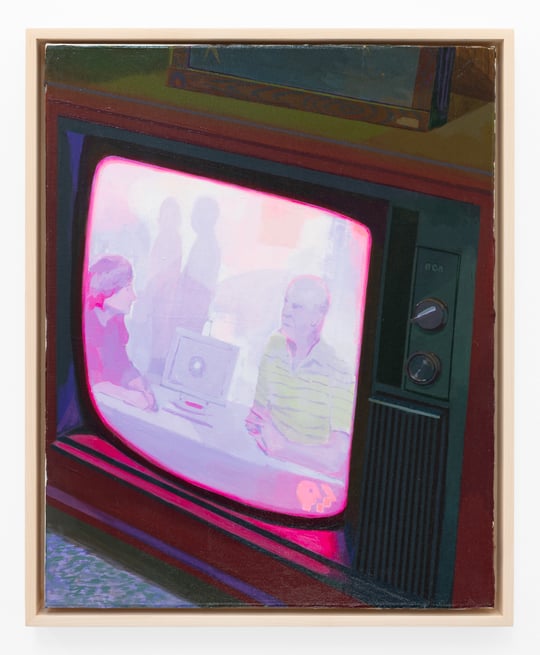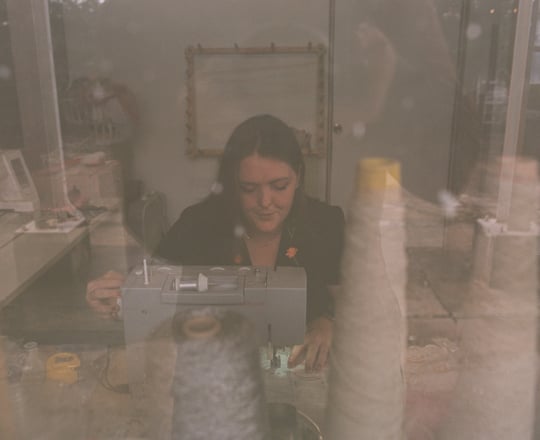
Contemporary art may roll its eyes at en plein air painting, but battalions of traditional painters embrace it. The portable easel, the small paint kit, the ecstatic mountain scene, the sun visor, the sports clothes: industries line up to sell the dream … and the equipment. There are magazines, workshops, competitions, and hordes of practitioners. Certainly not to be confused with highbrow painting, it’s a wonderful pastime! Like hunting, en plein air painting is a way to spend luxuriously long periods alone in the outdoors and come home with a souvenir.
Milwaukee-based artist and gallerist John Riepenhoff is not the typical representational landscape painter, nor is he a “local artist” in any conventional, insular sense. He embraces outdoor painting and his hometown, and yet he is clearly aligned with the illuminati of international art hipsters. His work has appeared at the Frieze Art Fair in London; Marlborough Gallery, Gavin Brown’s Enterprise, James Fuentes, and the Swiss Institute in New York; the Suburban (Michelle Grabner’s space) in Oak Park, Illinois, and an interesting list of others. This track record enables him to wryly twist an old world art mode into a jokey and yet also sincere practice. Curator Daniel Fuller’s choice to bring him to the Atlanta Contemporary Art Center is interesting, given the local tension we sometimes have here between traditional and contemporary art communities.
Riepenhoff exudes an updated pastoral romanticism (or at least that’s his act): he likes to know a place by its night sky. The artist challenges a fine art culture that is urban-based with a sort of beautifully simplistic or naive approach. He makes large-scale sky paintings wherever he travels with his road act (Fuller notes that the artist’s suitcase, stuffed with outdoors painting equipment, is larger than any other piece of his luggage). This summer, the artist set up camp in the Contemporary’s outdoor courtyard over several days in preparation for an exhibition in conjunction with this year’s Art Party. Atlanta is a suburban-spaced city, meaning that on a clear night we can actually observe the constellations. This is not so in denser cities. (Are paintings from Chicago or New York hazy?) Riepenhoff pays straightforward tribute to this condition.

The resulting three paintings, displayed at the Contemporary through November 7, are airy and uncomplicated. Loose gestures of dark blue paint dot and smear the raw canvas to make an abstract documentation on an environmental scale. Instead of realism, which is what we’ve come to expect of en plein air paintings, Riepenhoff switches to the vocabulary of Abstract Expressionism. One painting is so large that we literally walk through it, from behind, into the main exhibition space.
In the gallery, it appears as if 11 people are holding canvases in front of their bodies — only their legs show — so hilariously realistic (and dressed in fashionable urban attire), that one might empathize with how hard it must be for them to hold still. They resemble those poor souls whose job it is to hold and spin large commercial signage within sight of traffic. The canvases they hold are typical studio paintings made by an assortment of contemporary artists from Milwaukee, Chicago, New York, Los Angeles, Detroit, and Atlanta, including Atlanta’s Kojo Griffin and Birmingham’s Amy Pleasant. Alas, if one enters from “backstage,” through the canvas curtain, the sculptures are immediately revealed as legs-only dummies — perhaps a reference to all the people who worked behind the scene. Indeed, the business of selling and moving art objects takes a village.
A somewhat hidden video, projected into a corner behind the paintings, documents the making of the Atlanta project. In one scene, an invisible man (or woman) stars in the role of painter. A paint brush dangles and dances before the canvas. There is no human in sight. Off camera, Riepenhoff is the puppeteer. He says he wants to take the hand of the individual artist out of the picture. A ridiculous spoof on Klein’s action paintings or Pollock’s drips, is this a fun-loving joke, or is it possibly more sinister?

Although not explicitly stated in the label, the resulting piece is referred to as “ghost painting.” Is the artist invoking another old joke: “Even my six-year-old could do it”? Formally, “ghost painting” is his most aesthetically successful piece. But that’s not the point. Riepenhoff’s plein air paintings, with their sense of freedom and joy, are clearly about the process. Any aesthetic success seems a somewhat arbitrary byproduct. (Riepenhoff did not want to use a ladder but instead invented a special painting prosthesis to reach the upper portions of the largest pieces. He screwed multiple brushes together into an extra wide brush, much like the kind of tools used by 20th-century artists Gerhard Richter and Jack Whitten.)
Personally, I’ve been expecting a new plein air movement. It is rare for painters to work without photography. Returning to the outdoors and making art directly from that experience seems a natural next course for emerging environmental or land artists. Artists (and people in general) have become quite dependent on technology to mediate and represent our environment. But the incredible physicality of painting has become so self-aware, slick, and commodified; it must differentiate itself from humble Sunday painters or lose its cachet. It’s safe to say that contemporary art is threatened by traditionalism and nonurban viewpoints. By calling it plein air, a contemporary artist trespasses on some interesting traditional ground. Can the two genres share the same territory? In Riepenhoff’s case, they do so winningly, and with a wink.
John Riepenhoff’s show is on view at the Atlanta Contemporary through November 7.
Karen Tauches is a local designer, artist, and curator.




